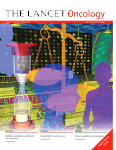LANCET ONCOL:基因标志预知前列腺癌患者的存活时间
2012-12-10 mumu 生物谷
目前,前列腺癌患者的存活时间差别很大,临床上迫切需要一种预测性模型,以便评估前列腺癌在患者中的攻击性。特别是,晚期前列腺癌的预后往往只能通过临床症状进行预测,有时肿瘤活检可能会提供些适度预测性结果。 在这一研究中,研究人员对202例难治性前列腺癌男性患者血样展开研究,发现了难治性前列腺癌的六个特征性基因。带6基因标志的男
目前,前列腺癌患者的存活时间差别很大,临床上迫切需要一种预测性模型,以便评估前列腺癌在患者中的攻击性。特别是,晚期前列腺癌的预后往往只能通过临床症状进行预测,有时肿瘤活检可能会提供些适度预测性结果。
在这一研究中,研究人员对202例难治性前列腺癌男性患者血样展开研究,发现了难治性前列腺癌的六个特征性基因。带6基因标志的男性具有高患病风险,存活时间为7.8个月,但不带6基因标志的男性则为低患病风险,存活时间近34.9个月。同时,开展了另一个涉及140例患者的重复研究,进一步验证了上述的研究结果。
这个6基因模型,在一个简单血液测试便能具体实施,可让临床医生为患者更好地确定治疗路线与临床试验适合性,还会形成更多晚期疾病的针对性研究。在临床上,这项研究体现了6基因模型血液测试在确定存活时间方面的作用。此外,该模型的6个基因能表明疾病晚期时免疫系统的可能变化,而且这些可能变化还可作为免疫疗法靶标以便深入研究。
研究人员正在进行更多的相关研究,以探索6基因标志的可行性、稳定性及其预测能力。
与前列腺癌相关的拓展阅读:
- LANCET ONCOL:基因标志预知前列腺癌患者的存活时间
- Am J Clin Nutr:每日喝汽水增患前列腺癌风险
- Lancet Oncol述评:前列腺癌患者的去势治疗维持时间尚需研究
- Science:MYC基因与大肠癌和前列腺癌有关
- 饮用大量绿茶或可以抑制前列腺癌
- ESMO年会:来那度胺治疗晚期前列腺癌生存率低
- The Lancet Oncology: 利用基因活动的特点快速检测前列腺癌
- 阿仑膦酸钠减少前列腺癌因接受ADT疗法引起的骨密度降低 更多信息请点击:有关前列腺癌更多资讯
原文链接 http://www.sciencedaily.com/releases/2012/10/121010151234.htm

doi:10.1016/S1470-2045(12)70263-2
PMC:
PMID:
A whole-blood RNA transcript-based prognostic model in men with castration-resistant prostate cancer: a prospective study
Robert W Ross, Matthew D Galsky, Howard I Scher, Jay Magidson, Karl Wassmann, Gwo-Shu Mary Lee, Leah Katz, Sumit K Subudhi, Aseem Anand, Martin Fleisher, Philip W Kantoff, William K Oh
Background Survival for patients with castration-resistant prostate cancer is highly variable. We assessed the effectiveness of a whole-blood RNA transcript-based model as a prognostic biomarker in castration-resistant prostate cancer. Methods Peripheral blood was prospectively collected from 62 men with castration-resistant prostate cancer on various treatment regimens who were enrolled in a training set at the Dana-Farber Cancer Institute (Boston, MA, USA) from August, 2006, to June, 2008, and from 140 patients with castration-resistant prostate cancer in a validation set from Memorial Sloan-Kettering Cancer Center (New York, NY, USA) from August, 2006, to February, 2009. A panel of 168 inflammation-related and prostate cancer-related genes was assessed with optimised quantitative PCR to assess biomarkers predictive of survival. Findings A six-gene model (consisting of ABL2, SEMA4D, ITGAL, and C1QA, TIMP1, CDKN1A) separated patients with castration-resistant prostate cancer into two risk groups: a low-risk group with a median survival of more than 34·9 months (median survival was not reached) and a high-risk group with a median survival of 7·8 months (95% CI 1·8-13·9; p<0·0001). The prognostic utility of the six-gene model was validated in an independent cohort. This model was associated with a significantly higher area under the curve compared with a clinicopathological model (0·90 [95% CI 0·78-0·96] vs 0·65 [0·52-0·78]; p=0·0067). Interpretation Transcriptional profiling of whole blood yields crucial prognostic information about men with castration-resistant prostate cancer. The six-gene model suggests possible dysregulation of the immune system, a finding that warrants further study.
(责任编辑:yan.mao)
分享到:本网站所有内容来源注明为“梅斯医学”或“MedSci原创”的文字、图片和音视频资料,版权均属于梅斯医学所有。非经授权,任何媒体、网站或个人不得转载,授权转载时须注明来源为“梅斯医学”。其它来源的文章系转载文章,或“梅斯号”自媒体发布的文章,仅系出于传递更多信息之目的,本站仅负责审核内容合规,其内容不代表本站立场,本站不负责内容的准确性和版权。如果存在侵权、或不希望被转载的媒体或个人可与我们联系,我们将立即进行删除处理。
在此留言










#存活时间#
69
#Oncol#
48
#Lancet#
45